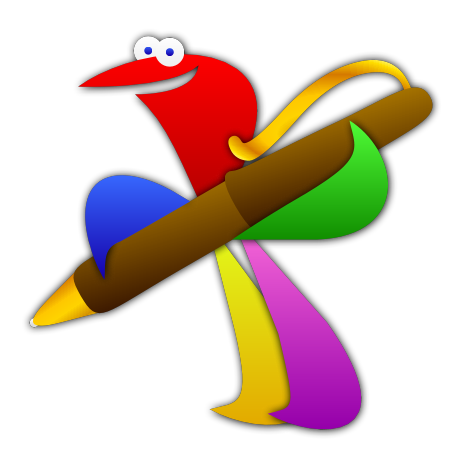By most any measure, Many Tricks is not a big company—there are only two of us, and we’ve only got a handful of products. Complicating this relatively-simple small business, though, is the fact that we are separated by 5,327 miles (according to Google Earth), and nine clock hours.
Given our small size and geographic separation, we need to work efficiently individually, and doubly so during those few hours each day when our schedules overlap (typically from about 5:00am to 12:00pm, west coast USA time). So what tools do we use to keep in touch, to manage our web site, and to run the business? Keep reading for a behind-the-scenes look at the apps that keep Many Tricks humming.
As this post turned out much longer than either of us expected, we’ve broken it into two parts. This first part covers the tools we use to create our apps and handle our online activities; the second part will discuss running the business side of the company and general Mac tools that aren’t directly related to any of the prior categories.
Here’s a look at the key programs we use to create our apps and manage our online presence. (Note that we don’t include our own apps on these lists, but both of us use them extensively, as you might guess.)
Creating our applications
From Peter’s point of view:
- Xcode (free): Write code, compile it, and tear your hair out because of errors you don’t understand—Xcode lets you do all of that, and it’s the development environment the vast majority of Mac/iPhone developers uses. I haven’t worked with any other IDE in years, so I don’t really know how it stacks up against other contemporary environments, but one thing I can say is that I really, honestly like Xcode. It’s quite successful at making a developer’s life as easy as possible, and Apple has improved Xcode steadily ever since Mac OS X saw the light of day. In my opinion, Xcode is an archetypical example of what’s great about Apple.
- Canvas (discontinued for Mac OS X): I try not to create icons anymore, because I’m just not that good at it, but whenever there’s an immediate need for doing vector graphics, I still fire up Canvas, which helped create the Butler and Name Mangler app icons, among others, in the past. This is the only major graphics application I ever really learnt to use, so it’s a pity they don’t make it for the Mac anymore. Like so many successful pieces of software, Canvas was first created for the Mac, and I remember the times when most of the Mac users I knew worked with Canvas on a daily basis. Eventually, though, Canvas’ original maker, Deneba, was acquired by ACD systems, and those guys just didn’t like the Mac that much, I guess. So I’ll have to switch to another app one day, but for now, I’m just glad Canvas X still runs on Mac OS X 10.6.
- GraphicConverter ($34.95): GraphicConverter is the swiss army knife of editing and converting image files on the Mac. It was the first Mac shareware app I became aware of when I started working on a Mac regularly during the Mac OS 8 days, and to this day, I find myself using it all the time, be it for quickly optimizing a scaled-down version of an icon, converting a PNG to a favicon, or any other of those minor graphics tasks one faces every day.
- DropDMG ($24) and DMGCanvas ($15): Both of these let you create those spiffy DMG disk image files that are the quasi-standard for distributing Mac software these days. Conceptually, they are quite different, and I’m an avid user of both of them, enjoying the fact that I have tailor-made tools for different tasks—such as packaging software for release (DMGCanvas) and archiving stuff (DropDMG)—at my disposal.
- Time (invaluable): While a solid Mac computer (or several of those, to be on the safe side) and some pieces of software are indispensable for developing, you’ll find that developers often just sit there, seemingly doing nothing while thinking about possible solutions to a problem, and possibly getting a little philosophical about it. So yes, state-of-the-art equipment is very important, but so is taking the time to come up with solutions you feel confident in.
Online activities
- Coda ($99): The Many Tricks web site is implemented on top of a very basic homebrewn content management system written in PHP, and it’s primarily coded and managed with Coda these days, after having been a Finder plus TextWrangler (see General Mac tools) plus Cyberduck (see below) project for years. We particularly like Coda’s ability to edit files on the server, its live previews, and the tabbed editing interface. Rob also uses Coda to create and edit all the help files for our apps.
- Safari and Firefox (both free): Peter prefers Safari, and Rob prefers Firefox, which is a pretty good combination—because we use the two dominant browsers on the Mac, we both work hard to make sure our web site works well in both of them. (We also test our site in the other major browsers, to make sure there aren’t any major issues.)
From Rob’s point of view:
- Trellis (free): Our support site, where you can submit requests for help, ask for new features, and browse our knowledge base, is powered by Trellis. While it’s not quite the perfect system (email submission/management of tickets would be great, and Peter is pretty much incompatible with its message editor) for our needs, it does about 80% of what I’d like it to do, and seems to be working relatively well.
- Transmit ($34): Sometimes I just need to get a bunch of files on the server. For those times, Transmit is my tool of choice. (For now, I’m sticking with Transmit 3.x, as I really dislike the interface in 4.x.)
- WordPress (free): Our blog is powered by WordPress, and I can’t say enough good things about it—from extensions to the most brain-dead-simple updates I’ve ever seen in a web app, WordPress makes it super easy to create and maintain a blog.
From Peter’s point of view:
- Cyberduck (donations welcome): Transferring files to and from our server after having edited them offline used to be Cyberduck’s job, and it did it both reliably and with a sense of user interface style that was unmatched by any other Mac FTP client for years. We don’t currently use Cyberduck for the reasons outlined above, but it is undoubtedly an important part of Many Tricks’ history.
Stay tuned for Part 2 tomorrow…
 Many Tricks
Many Tricks

Thanks a lot for letting us in. Although I know that you have no obligation whatsoever to tell us anything beyond what concerns your apps, I really appreciate to know a bit more of the people who create such great stuff. Hey, I’d even love to see pix of your cats, if you have some, that is ;-)
Been using File List several times a week for many years (since 2005) – very useful, thanks! Often tried to update it but for some reason none of your sites ever seemed to work. Finally found this site and have just bought Name Mangler out of solidarity for all those years of free use :-) I don’t really need the upgrade as v1.2 still seems to do the job of stripping out spaces fine… BTW, I see you use much of the same software I use too :-)
Thanks, gabe!
BTW, newer Name Mangler versions don’t just sport additional features, they are also cleverer about certain scenarios. For instance, renaming a sequence of files to an overlapping set of names (e.g., “1.txt; 2.txt; 3.txt” → “2.txt; 3.txt; 4.txt”) now just works, instead of overwriting files with conflicting names.